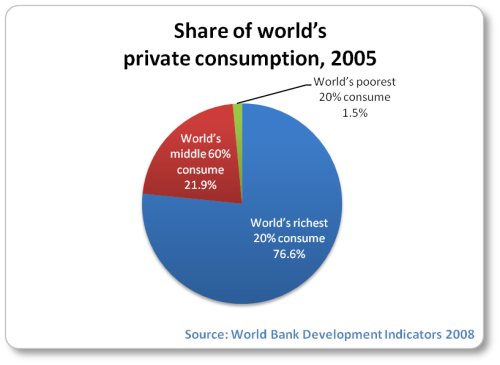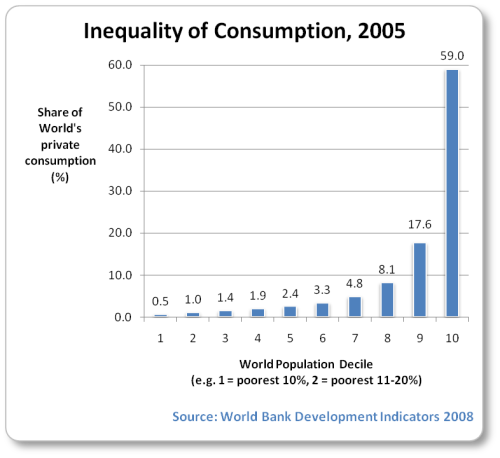Consumption and Consumerism
Author and Page information
- This page: https://www.globalissues.org/issue/235/consumption-and-consumerism.
- To print all information (e.g. expanded side notes, shows alternative links), use the print version:
Global inequality in consumption, while reducing, is still high.
Using latest figures available, in 2005, the wealthiest 20% of the world accounted for 76.6% of total private consumption. The poorest fifth just 1.5%:

Breaking that down slightly further, the poorest 10% accounted for just 0.5% and the wealthiest 10% accounted for 59% of all the consumption:

In 1995, the inequality in consumption was wider, but the United Nations also provided some eye-opening statistics (which do not appear available, yet, for the later years) worth noting here:
Today’s consumption is undermining the environmental resource base. It is exacerbating inequalities. And the dynamics of the consumption-poverty-inequality-environment nexus are accelerating. If the trends continue without change — not redistributing from high-income to low-income consumers, not shifting from polluting to cleaner goods and production technologies, not promoting goods that empower poor producers, not shifting priority from consumption for conspicuous display to meeting basic needs — today’s problems of consumption and human development will worsen.
… The real issue is not consumption itself but its patterns and effects.
… Inequalities in consumption are stark. Globally, the 20% of the world’s people in the highest-income countries account for 86% of total private consumption expenditures — the poorest 20% a minuscule 1.3%. More specifically, the richest fifth:
- Consume 45% of all meat and fish, the poorest fifth 5%
- Consume 58% of total energy, the poorest fifth less than 4%
- Have 74% of all telephone lines, the poorest fifth 1.5%
- Consume 84% of all paper, the poorest fifth 1.1%
- Own 87% of the world’s vehicle fleet, the poorest fifth less than 1%
Runaway growth in consumption in the past 50 years is putting strains on the environment never before seen.
If they were available, it would likely be that the breakdowns shown for the 1995 figures will not be as wide in 2005. However, they are likely to still show wide inequalities in consumption. Furthermore, as a few developing countries continue to develop and help make the numbers show a narrowing gap, there are at least two further issues:
- Generalized figures hide extreme poverty and inequality of consumption on the whole (for example, between 1995 and 2005, the inequality in consumption for the poorest fifth of humanity has hardly changed)
- If emerging nations follow the same path as today’s rich countries, their consumption patterns will also be damaging to the environment
And consider the following, reflecting world priorities:
| Global Priority | $U.S. Billions |
|---|---|
| Cosmetics in the United States | 8 |
| Ice cream in Europe | 11 |
| Perfumes in Europe and the United States | 12 |
| Pet foods in Europe and the United States | 17 |
| Business entertainment in Japan | 35 |
| Cigarettes in Europe | 50 |
| Alcoholic drinks in Europe | 105 |
| Narcotics drugs in the world | 400 |
| Military spending in the world | 780 |
And compare that to what was estimated as additional costs to achieve universal access to basic social services in all developing countries:
| Global Priority | $U.S. Billions |
|---|---|
| Basic education for all | 6 |
| Water and sanitation for all | 9 |
| Reproductive health for all women | 12 |
| Basic health and nutrition | 13 |
(Source: The state of human development, United Nations Human Development Report 1998, Chapter 1, p.37)
We consume a variety of resources and products today having moved beyond basic needs to include luxury items and technological innovations to try to improve efficiency. Such consumption beyond minimal and basic needs is not necessarily a bad thing in and of itself, as throughout history we have always sought to find ways to make our lives a bit easier to live. However, increasingly, there are important issues around consumerism that need to be understood. For example:
- How are the products and resources we consume actually produced?
- What are the impacts of that process of production on the environment, society, on individuals?
- What are the impacts of certain forms of consumption on the environment, on society, on individuals?
- Which actors influence our choices of consumption?
- Which actors influence how and why things are produced or not?
- What is a necessity and what is a luxury?
- How do demands on items affect the requirements placed upon the environment?
- How do consumption habits change as societies change?
- Businesses and advertising are major engines in promoting the consumption of products so that they may survive. How much of what we consume is influenced by their needs versus our needs?
- Also influential is the very culture of today in many countries, as well as the media and the political institutions themselves. What is the impact on poorer nations and people on the demands of the wealthier nations and people that are able to afford to consume more?
- How do material values influence our relationships with other people?
- What impact does that have on our personal values?
- And so on.
Just from these questions, we can likely think of numerous others as well. We can additionally, see that consumerism and consumption are at the core of many, if not most societies. The impacts of consumerism, positive and negative are very significant to all aspects of our lives, as well as our planet. But equally important to bear in mind in discussing consumption patterns is the underlying system that promotes certain types of consumption and not other types.
Inherent in today’s global economic system is the wasteful use of resources, labor and capital. These need to be addressed. Waste is not only things like via not recycling etc; it is deep within the system.
The U.N. statistics above are hard hitting, highlight one of the major impacts of today’s form of corporate-led globalization.
Over
population is usually blamed as the major cause of environmental degradation, but the above statistics strongly suggests otherwise. As we will see, consumption patterns today are not to meet everyone’s needs. The system that drives these consumption patterns also contribute to inequality of consumption patterns too.
This section of the globalissues.org web site will attempt to provide an introductory look at various aspects of what we consume and how.
- We will see possible
hidden
costs of convenient items to society, the environment and individuals, as well as the relationship with various sociopolitical and economic effects on those who do consume, and those who are unable to consume as much (due to poverty and so on). - We will look at how some luxuries were turned into necessities in order to increase profits.
- This section goes beyond the
don’t buy this product
type of conclusion to the deeper issues and ramifications. - We will see just a hint at how wasteful all this is on resources, society and capital. The roots of such disparities in consumption are inextricably linked to the roots of poverty. There is such enormous waste in the way we consume that an incredible amount of resources is wasted as well. Furthermore, the processes that lead to such disparities in unequal consumption are themselves wasteful and is structured deep into the system itself. Economic efficiency is for making profits, not necessarily for social good (which is treated as a side effect). The waste in the economic system is, as a result, deep. Eliminating the causes of this type of waste are related to the elimination of poverty and bringing rights to all. Eliminating the waste also allows for further equitable consumption for all, as well as a decent standard of consumption.
- So these issues go beyond just consumption, and this section only begins to highlight the enormous waste in our economy which is not measured as such.
- A further bold conclusion is also made that elimination of so much wasted capital would actually require a reduction of people’s workweek. This is because the elimination of such waste means entire industries are halved in size in some cases. So much labor redundancy cannot be tolerated, and hence the answer is therefore to share the remaining productive jobs, which means reducing the workweek!
- We will see therefore, that political causes of poverty are very much related to political issues and roots of consumerism. Hence solutions to things like hunger, environmental degradation, poverty and other problems have many commonalities that would need to be addressed.
Entire volumes of research can be written on this topic so these pages provide just an insight to these issues!
14 articles on “Consumption and Consumerism” and 3 related issues:
Creating the Consumer
This section looks at the rise of the consumer and the development of the mass consumer society. While consumption has of course been a part of our history, in the last 100 years or so, the level of mass consumption beyond basics has been exponential and is now a fundamental part of many economies. Luxuries that had to be turned into necessities and how entire cultural habits had to be transformed for this consumption is introduced here.
Read “Creating the Consumer” to learn more.
Children as Consumers
 The market for children’s products and food is enormous. Parents on the one hand have a hard time raising children the way they want to, while on the other hand, kids are being increasingly influenced by commercialism that often goes against what parents are trying to do.
The market for children’s products and food is enormous. Parents on the one hand have a hard time raising children the way they want to, while on the other hand, kids are being increasingly influenced by commercialism that often goes against what parents are trying to do.
Read “Children as Consumers” to learn more.
Effects of Consumerism
Because consumption is so central to many economies, and even to the current forms of globalization, its effects are also seen around the world. How we consume, and for what purposes drives how we extract resources, create products and produce pollution and waste. Issues relating to consumption hence also affect environmental degradation, poverty, hunger, and even the rise in obesity that is nearing levels similar to the official
global poverty levels. Political and economic systems that are currently promoted and pushed around the world in part to increase consumption also lead to immense poverty and exploitation. Much of the world cannot and do not consume at the levels that the wealthier in the world do. Indeed, the above U.N. statistics highlight that very sharply. In fact, the inequality structured within the system is such that as Richard Robbins says, some one has to pay
for the way the wealthier in the world consume.
Read “Effects of Consumerism” to learn more.
Tobacco
 It is well known that tobacco smoking kills millions. But it also exacerbates poverty, contributes to world hunger by diverting prime land away from food production, damages the environment and reduces economic productivity. Second hand smoking also affects other people’s lives.
It is well known that tobacco smoking kills millions. But it also exacerbates poverty, contributes to world hunger by diverting prime land away from food production, damages the environment and reduces economic productivity. Second hand smoking also affects other people’s lives.
Despite many attempts to prevent it, a global tobacco control treaty became international law in 2005.
However, challenges still remain as tobacco companies try to hit back, for example, by targeting developing nations, increasing advertising at children and women, attempting to undermine global treaties and influence trade talks, etc.
Read “Tobacco” to learn more.
Obesity
 Obesity typically results from over-eating (especially an unhealthy diet) and lack of enough exercise.
Obesity typically results from over-eating (especially an unhealthy diet) and lack of enough exercise.
In our modern world with increasingly cheap, high calorie food (example, fast food — or junk food
), prepared foods that are high in things like salt, sugars or fat, combined with our increasingly sedentary lifestyles, increasing urbanization and changing modes of transportation, it is no wonder that obesity has rapidly increased in the last few decades, around the world.
The number of people overweight or obese is now rivaling the number of people suffering from hunger around the world. Obese people were thought to be mainly from richer countries or wealthier segments of society, but poor people can also suffer as the food industry supplies cheaper food of poorer quality.
Environmental, societal and life-style factors all have an impact on obesity and health. While individuals are responsible for their choices, other actors such as the food industry are also part of the problem, and solution. Unfortunately, the food industry appears reluctant to take too many measures that could affect their bottom line, preferring to solely blame individuals instead.
Read “Obesity” to learn more.
Sugar
In this section, we look at the example of sugar consumption; how it has arisen (as it was once a luxury, now turned into a necessity
). We look at things like how it affects the environment; the political and economic drivers in producing sugar (for example, historically, sugar plantations encouraged slavery); its health effects today; its relation to world hunger (as land used to grow sugar and related support, for export, could be used to grow food for local consumption); and so on. As we will also see, it is an example of a wasteful
industry. That is, so many resources go into this industry compared to what might be needed. This wastes labor, wastes capital and uses up many resources.
Read “Sugar” to learn more.
Beef
 Beef, like sugar, is another vivid example of using resources wastefully, degrading the environment, contributing to hunger, poor health and more.
Beef, like sugar, is another vivid example of using resources wastefully, degrading the environment, contributing to hunger, poor health and more.
More than one third of the world’s grain harvest is used to feed livestock. Some 70 to 80% of grain produced in the United States is fed to livestock. A lot of rainforest in the Amazon and elsewhere are cleared for raising cattle — not so much for local consumption, but for fast food restaurants elsewhere.
There are enormous related costs of what is an inefficient
process when considered as a whole. Subsidies in farming in the US and elsewhere end up encouraging unhealthy foods to be cheaper than healthy foods. Just factoring in the cost of water alone, a more realistic estimate of the real cost of common hamburger meat would be $35 a pound!
As with sugar, beef was a luxury turned into an everyday item. Like sugar, it is also an example of how people’s tastes are influenced and how demands
can be created (or very much expanded), rather than meeting some natural
demand.
Read “Beef” to learn more.
Bananas
 The banana industry in Latin America and the Caribbean also touches many other issues. Rainforest destruction is one effect of the banana industry.
The banana industry in Latin America and the Caribbean also touches many other issues. Rainforest destruction is one effect of the banana industry.
Dependent economies is another, where bananas are grown not to feed local people and meet their demands, but to create exports for Europe and America. The recent trade disputes between those two regions have received the most attention. However, the focus of the debate is limited. It continues to leave both dependent Latin American nations, and the Caribbean nations in poverty and hunger, while Latin American nations, large multinational American banana corporations and the American government seek to destroy the Caribbean banana economy, via the World Trade Organization, in order to gain dominant access to the European markets.
So many resources are poured into the banana industry, and like the sugar and beef examples, there is a lot of unnecessary use of resources that could otherwise be freed up to help local people in a way that is also less degrading to the surrounding environment.
Read “Bananas” to learn more.
Wasted Wealth, Capital, Labor and Resources
We are beginning to get just a hint of how wasteful our societies are. Sugar, beef, and bananas are just the tip of the iceberg in terms of examples of wasted industry and waste structured within the current system. Not only are certain wasteful job functions unnecessary as a result, but the capital that employs this labor is therefore a wasteful use of capital. As a result, we see waste and misuse of the environment, as well as social and environmental degradation increasing. Our industries may be efficient for accumulating capital and making profits, but that does not automatically mean that it is efficient for society. However, with such wasted labor
what do we do? We can’t have such an enormous idle labor force, right? Well, as J.W. Smith points out, we should share the remaining jobs. This would also reduce our workweek. Something technocrats have kept promising us in rhetoric only!
Read “Wasted Wealth, Capital, Labor and Resources” to learn more.
Mathematics of Wasted Labor—an Example
With kind permission from J.W. Smith, a part of the conclusion to Part I of World’s Wasted Wealth II (Institute for Economic Democracy, 1994) has been reproduced on this page. That part is titled The Mathematics of Wasted Labor. It is a vivid example of wasted and unnecessary labor using the United States as the case study. While the book was written back in 1994 and the numbers, facts and estimates are hence based on data from the early 1990s, the pattern and examples shown here are still very valid. His calculations suggest that with the elimination of wasted labor in the U.S. and sharing the remaining productive jobs between all those who can work, workers would need to work just 2.4 days per week!
Read “Mathematics of Wasted Labor—an Example” to learn more.
Energy Security
 Energy security is a growing concern for rich and emerging nations alike. The past drive for fossil fuel energy has led to wars, overthrow of democratically elected leaders, and puppet governments and dictatorships.
Energy security is a growing concern for rich and emerging nations alike. The past drive for fossil fuel energy has led to wars, overthrow of democratically elected leaders, and puppet governments and dictatorships.
Leading nations admit we are addicted to oil, but investment into alternatives has been lacking, or little in comparison to fossil fuel investments.
As the global financial crisis takes hold and awareness of climate change increases, more nations and companies are trying to invest in alternatives. But will the geopolitics remain the same?
Read “Energy Security” to learn more.
Illicit Drugs
The global illicit drugs market is enormous, estimated at some $320 billion. This makes it one of the largest businesses in the world. Some believe in strong prohibition enforcement. Others argue for decriminalization to minimize the crime and health effects associated with the market being controlled by criminals. Are there merits to each approach?
Read “Illicit Drugs” to learn more.
Pineapples
 Pineapples are nutritious and popular. But the cheap fruit comes at a high cost. Health and environmental degradation has affected both workers and local communities. Price cuts in European supermarkets has led to wage cuts for workers already earning very little.
Pineapples are nutritious and popular. But the cheap fruit comes at a high cost. Health and environmental degradation has affected both workers and local communities. Price cuts in European supermarkets has led to wage cuts for workers already earning very little.
Read “Pineapples” to learn more.
Consumption and Consumerism Links and Resources
Because this topic is vast, I cannot expect to write everything here! In addition, due to the overlapping and inter-related nature of so many issues, throughout this web site topics are presented which can also be looked at from this waste perspective. Such links as well as links to other web site, books and so on are presented here.
Read “Consumption and Consumerism Links and Resources” to learn more.
Environmental Issues
 Environmental issues are also a major global issue. Humans depend on a sustainable and healthy environment, and yet we have damaged the environment in numerous ways. This section introduces other issues including biodiversity, climate change, animal and nature conservation, population, genetically modified food, sustainable development, and more.
Environmental issues are also a major global issue. Humans depend on a sustainable and healthy environment, and yet we have damaged the environment in numerous ways. This section introduces other issues including biodiversity, climate change, animal and nature conservation, population, genetically modified food, sustainable development, and more.
Read “Environmental Issues” to learn more.
Sustainable Development
Read “Sustainable Development” to learn more.
Trade, Economy, & Related Issues
Read “Trade, Economy, & Related Issues” to learn more.
Author and Page Information
- Created:
- Last updated:
 Global Issues
Global Issues